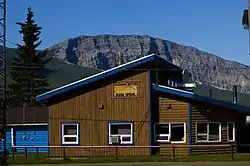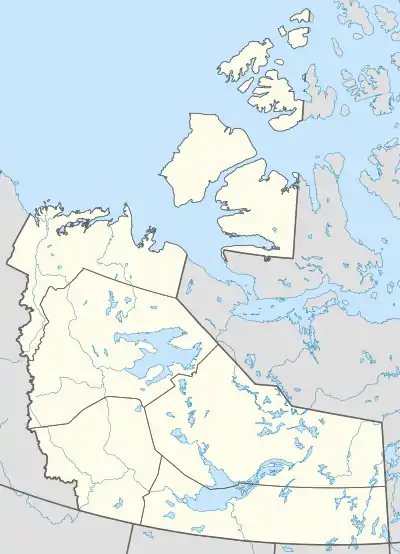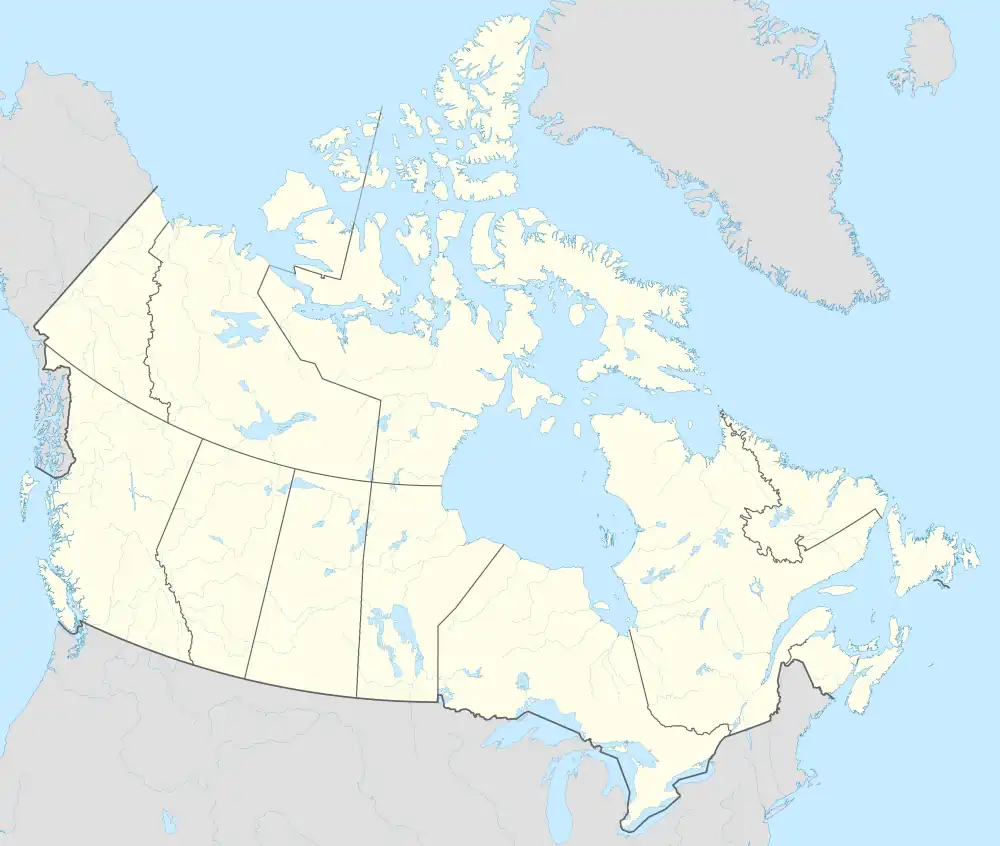Nahanni Butte
Tthenáágó | |
|---|---|
First Nations/Dene Band - Designated Authority (Nahanni Butte Dene Band) | |
 The Band Office in Nahanni Butte | |
 Nahanni Butte  Nahanni Butte | |
| Coordinates: 61°02′02″N 123°22′50″W / 61.03389°N 123.38056°W | |
| Country | Canada |
| Territory | Northwest Territories |
| Region | Dehcho Region |
| Constituency | Nahendeh |
| Census division | Region 4 |
| Government | |
| • Chief | Steve Vital |
| • Management Consultant | Soham Srimani |
| • MLA | Shane Thompson |
| Area | |
| • Land | 78.99 km2 (30.50 sq mi) |
| Elevation | 182 m (597 ft) |
| Population (2016)[1] | |
| • Total | 87 |
| • Density | 1.1/km2 (3/sq mi) |
| Time zone | UTC−07:00 (MST) |
| • Summer (DST) | UTC−06:00 (MDT) |
| Canadian Postal code | X0E 0C1 & X0E 2N0 |
| Area code | 867 |
| Telephone exchange | 602 |
| - Living cost | 147.5A |
| - Food price index | 139.4B |
| Sources: Department of Municipal and Community Affairs,[2] Prince of Wales Northern Heritage Centre,[3] Canada Flight Supplement[4] ^A 2013 figure based on Edmonton = 100[5] ^B 2015 figure based on Yellowknife = 100[5] | |
Nahanni Butte (/nəˈhæni/ nə-HAN-ee; Slavey language: Tthenáágó [t̪θɛnáːkó] "strong rock") is a "Designated Authority"[6] in the Dehcho Region of the Northwest Territories, Canada. The community is located at the confluence of the Liard and South Nahanni Rivers in the southwestern part of the NWT.
Although it was not normally accessible by road, a winter road was constructed yearly until an all-season road was completed in October 2010 as far as the Liard River. Access from there is by river taxi in summer and ice road in winter; there are no plans for a vehicle ferry.
Demographics
|
| ||||||||||||||||||||||||||||||||||||||||||||||||||||||||||||||||||||||||
| Sources: NWT Bureau of Statistics (2001 - 2017)[15] | |||||||||||||||||||||||||||||||||||||||||||||||||||||||||||||||||||||||||
In the 2021 Census of Population conducted by Statistics Canada, Nahanni Butte had a population of 81 living in 33 of its 39 total private dwellings, a change of -6.9% from its 2016 population of 87. With a land area of 79.42 km2 (30.66 sq mi), it had a population density of 1.0/km2 (2.6/sq mi) in 2021.[14]
In 2016, there were 80 First Nations people and 40 people speak a Slavey language.[1]
First Nations
The Dene of the community are represented by the Nahɂą Dehé Dene Band and belong to the Dehcho First Nations.[16]
See also
References
- 1 2 3 4 "Population and dwelling counts, for Canada, provinces and territories, and census subdivisions (municipalities), 2016 and 2011 censuses – 100% data (Northwest Territories)". Statistics Canada. February 8, 2017. Retrieved February 1, 2022.
- ↑ "NWT Communities - Nahanni Butte". Government of the Northwest Territories: Department of Municipal and Community Affairs. Retrieved 2014-01-29.
- ↑ "Northwest Territories Official Community Names and Pronunciation Guide". Prince of Wales Northern Heritage Centre. Yellowknife: Education, Culture and Employment, Government of the Northwest Territories. Archived from the original on 2016-01-13. Retrieved 2016-01-13.
- ↑ Canada Flight Supplement. Effective 0901Z 16 July 2020 to 0901Z 10 September 2020.
- 1 2 Nahanni Butte - Statistical Profile at the GNWT
- ↑ Differences in Community Government Structure
- ↑ "1981 Census of Canada: Census subdivisions in decreasing population order" (PDF). Statistics Canada. May 1992. Retrieved February 1, 2021.
- ↑ "1986 Census: Population - Census Divisions and Census Subdivisions" (PDF). Statistics Canada. September 1987. Retrieved February 1, 2022.
- ↑ "91 Census: Census Divisions and Census Subdivisions - Population and Dwelling Counts" (PDF). Statistics Canada. April 1992. Retrieved February 1, 2022.
- ↑ "96 Census: A National Overview - Population and Dwelling Counts" (PDF). Statistics Canada. April 1997. Retrieved February 1, 2022.
- ↑ "Population and Dwelling Counts, for Canada, Provinces and Territories, and Census Subdivisions (Municipalities), 2001 and 1996 Censuses - 100% Data (Northwest Territories)". Statistics Canada. August 15, 2012. Retrieved February 1, 2022.
- ↑ "Population and dwelling counts, for Canada, provinces and territories, and census subdivisions (municipalities), 2006 and 2001 censuses - 100% data (Northwest Territories)". Statistics Canada. August 20, 2021. Retrieved February 1, 2022.
- ↑ "Population and dwelling counts, for Canada, provinces and territories, and census subdivisions (municipalities), 2011 and 2006 censuses (Northwest Territories)". Statistics Canada. July 25, 2021. Retrieved February 1, 2022.
- 1 2 "Population and dwelling counts: Canada, provinces and territories, and census subdivisions (municipalities), Northwest Territories". Statistics Canada. February 9, 2022. Retrieved February 18, 2022.
- ↑ Population Estimates By Community from the GNWT
- ↑ Dehcho First Nations Archived 2007-02-03 at the Wayback Machine